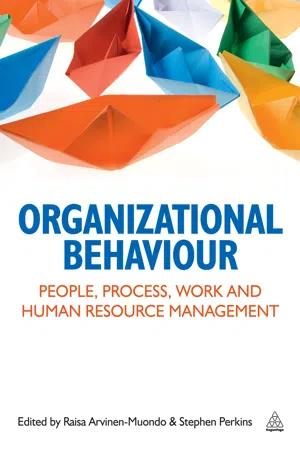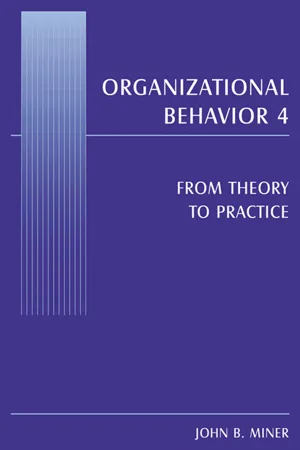Business
Herzberg Two Factor Theory
The Herzberg Two Factor Theory, also known as the Motivation-Hygiene Theory, suggests that there are two sets of factors that impact employee motivation and satisfaction at work. The theory identifies motivator factors, such as recognition and achievement, which lead to satisfaction, and hygiene factors, such as company policies and working conditions, which prevent dissatisfaction. According to Herzberg, addressing both sets of factors is essential for creating a positive work environment.
Written by Perlego with AI-assistance
Related key terms
Related key terms
1 of 4
Related key terms
1 of 3
9 Key excerpts on "Herzberg Two Factor Theory"
- eBook - ePub
Behavioural Research for Marketing
A Practitioner's Handbook
- Julian Adams(Author)
- 2022(Publication Date)
- Routledge(Publisher)
The employment survey was repeated a year later, levels of satisfaction had improved and dissatisfaction was lower. Further, absenteeism and staff turnover were markedly down from that observed in the previous year.4.2.5 Implications for behavioural research
- Herzberg’s theory makes clear that in the workplace there are two distinct human needs. Hygiene factors relate to physiological needs about pay and conditions and motivator factors relate to psychological needs about growth and fulfilment.
- The theory suggests that the opposite of satisfaction is not dissatisfaction and that employers need to consider how to best engender satisfaction whilst addressing possible dissatisfaction.
- Although Herzberg came up with his theory in the 1960s, his theory remains important in the field of employee management to this day.
4.2.6 References/further reading
- Herzberg, F., Mausner, B., and Snyderman, B. (1959). The Motivation to Work (2nd ed.). New York: John Wiley.
4.2.6.1 Want to know more?
- A more detailed review of Herzberg’s two-factor theory can be found in the following text: Herzberg, F. (1968). One More Time: How Do You Motivate Employees? Harvard Business Review, 46 (1), pp. 53–62.
4.3 Self-efficacy: harnessing the power of self-belief
4.3.1 Defining self-efficacy
Self-efficacy refers to an individual’s belief in their ability to organise and perform a task successfully. An individual’s self-efficacy will influence how they cope with the challenges they face in everyday life. Given this, self-efficacy affects most forms of behaviour and as such, is a key motivational force.4.3.2 Reviewing self-efficacy theory
4.3.2.1 Albert Bandura’s self-efficacy
The term self-efficacy is credited to Bandura (1982 ) and is defined as an individual’s judgement on how well they think they can execute a task. Like personality traits discussed earlier, self-efficacy can be considered as a dimension where participants load somewhere between strong and weak efficacy poles, as illustrated in Figure 4.11 - Michael L. Vasu, Debra W. Stewart, G. David Garson(Authors)
- 2017(Publication Date)
- Routledge(Publisher)
The Japanese upsurge of manufacturing productivity has engendered much interest in their management techniques. It has also engendered a new addition to the list of management theories; namely Theory Z. William Ouchi, drawing upon the work of McGregor, has postulated that America needs a new approach, Theory Z, if American management is to improve its productivity (Ouchi, 1981). Theory Z is a synthesis of elements of Japanese management and a Theory Y perspective on the value of human resources. Theory Z organizations place high value on long term employment, consensual decision making, individual responsibility, slow evaluation and promotion systems, and moderately specialized career paths. A Theory Z management approach has been attempted at a number of major American corporations such as Chrysler and it has its strong advocates (Joiner, 1985). Motivational models coming out of the humanistic psychology tradition see human motivation as a function of the need level at which a particular employee is operating (Doyle, 1992).Two Factor Theory
Frederick Herzberg, in his “Two Factor Theory of Motivation,” departs from the pure growth and development model and yet is rooted in it. He asks a simple question: “How do you install a generator in an employee?” In order to answer this question, he asks another, what do people want from their jobs? He asked employees to describe in detail the situations in which they felt very good or bad about their jobs. He then recorded and categorized those responses. He observed that the answers they gave when they were satisfied were different than those that they gave when they were dissatisfied. Herzberg, concluded that job attitudes where best described in terms of two factors he called dissatisfiers and motivators . Herzberg argued that factors leading to job satisfaction are different from those which lead to job dissatisfaction! In effect, he argued that a dual continuum existed and that the opposite of “satisfaction” is “no satisfaction” and the opposite of “dissatisfaction” is “no dissatisfaction.”Figure 5 is a graphic representation of Herzberg’s conceptual framework. Note, that the dual continuum underscores the existence of separate factors. The key to understanding the difference resides in the pleasure-pain principle. One set of needs stems from the person’s animal disposition and centers on the avoidance of loss of life, hunger, pain, sexual deprivation, and so on. The second dimension of human nature is pleasure-seeking oriented or motivation. Recall, Maslow’s need hierarchy! According to Herzberg, human beings have a compelling urge to reach their own potential by continuous psychological growth (Herzberg, 1966). Those aspects of work which are motivators- eBook - ePub
The John Adair Lexicon of Leadership
The Definitive Guide to Leadership Skills and Knowledge
- John Adair(Author)
- 2011(Publication Date)
- Kogan Page(Publisher)
In retrospect, the research work of Herzberg and his colleagues, and the studies which his theory has provoked, confirm the view that work in industry and large organizations can be a means for at least the partial satisfaction of people’s higher needs. Some support for Maslow’s theory of prepotence is also afforded by the finding that if work does not provide adequate means for meeting the lower needs, it is experienced as positively dissatisfying, more so than if opportunities for more intrinsic satisfactions are missing. Herzberg’s dualistic framework has a value as a stimulating and introductory visual sketchmap in teaching, but it becomes an over-simplification if taken beyond a certain point. Moreover, his apparent contradiction of Maslow turns out to be more a symptom of differences in casts of mind rather than anything more fundamental in theory.Herzberg’s particular contribution was his passionate concern for people, matched with an evangelistic fervour for the gospel that industrial work, as much as any other form of work, should serve the humanistic purpose of self-actualization. So much so that jobs which do not lend themselves to this end are to be ‘enriched’ until they do, or mechanized out of existence. In cases where mechanization or automation is impossible, ‘hygiene factors’, such as big financial rewards, must clearly be seen to be compensations for being subhuman.With a new faith in man and some professional ingenuity, however, it will be possible to enrich most jobs so that they win more of both intrinsic satisfactions and extrinsic rewards for the worker. In keeping with the behavioural science school as a whole, Herzberg’s public platform was that such job enrichment leads to more motivation, which in turn yields higher company profits.KEYPOINTS- It is worth giving close attention to Herzberg’s Motivation – Hygiene theory because there is a lot of truth in it. The factors which satisfy or motivate us at work are not the opposite of the ones that dissatisfy or demotivate us: they are not two sides of the same coin.
- The factors which make us unhappy are around the job itself. Using a medical metaphor, Herzberg called them the Hygiene factors. Improve these conditions and you will be reducing the level of dissatisfaction. But you won’t make people happy by this route alone.
- To improve satisfaction (and motivation) in a job, as opposed to mere contentment with a job, you have to tackle another set of factors: achievement , recognition , variety and creativity
- eBook - ePub
- Leonhard E. Bernold, S. M. AbouRizk(Authors)
- 2010(Publication Date)
- Wiley(Publisher)
Herzberg argued that both factors, motivators and psychological hygiene, are equally important in the workplace, but for different reasons. A good work environment will not serve as a motivator; but a poor work environment will serve as a demotivator.Figure 8.5Herzberg’s Most Important Motivational FactorsFigure 8.5 summarizes graphically Herzberg’s findings (comprising a large data set), which have since been confirmed by other researchers. The analysis resulted in a list of 16 high-priority factors: 6 most responsible for providing satisfaction and 10 hygiene factors responsible for causing the most dissatisfaction.Reviewing the graph we can see that the upper six factors align with Maslow’s intrinsic values of self-esteem, which result from recognition, advancement, and responsibility, while achievement, work itself, and personal growth align with self-actualization. The bottom 10 are of a totally different nature. In addition, each factor can, at sharply different magnitudes, serve as a satisfier as well as a dissatisfier. For example, receiving recognition leads to, at a high frequency, a high level of satisfaction. The lack of recognition, however, was found not to produce the concomitant level of dissatisfaction. The opposite was true for hygiene factors. “Toxic” supervisors create a lot of dissatisfaction for a large number of people, whereas exceptional supervisors produce only a small amount of satisfaction. Most interestingly, salary shows up as a hygiene factor, not a motivator. Although higher salaries might align with motivators such as recognition and achievement, the failure to be paid a salary that is deemed necessary to sustain a minimal level of economic self-sufficiency or to match the work effort will produce an equally strong feeling of dissatisfaction among a high percentage of workers.In summary, the large study that laid the foundation for Herzberg’s two-factor theory showed that motivating factors were responsible for 81 percent of job satisfaction mentioned by the workers covered in the study. Hygiene factors, such as company policy and administration, supervision, interpersonal relationships, working conditions, salary, and so on, were mentioned by 69 percent of the workers polled as causing dissatisfaction at work. - Michael Armstrong, Stephen Taylor(Authors)
- 2020(Publication Date)
- Kogan Page(Publisher)
Focuses attention on the various needs that motivate people and the notion that a satisfied need is no longer a motivator. The concept of a hierarchy has no practical significance. Two-factor model Related to needs theoryHerzberg et al(1957) Two groups of factors affect job satisfaction: (1) those intrinsic to the work itself; (2) those extrinsic to the job (extrinsic motivators or hygiene factors) such as pay and working conditions. Identifies a number of fundamental needs. It also indicates that satisfaction from a pay increase (extrinsic motivation) does not last long. Process/cognitive theory Expectancy theory Vroom (1964), Porter and Lawler (1968) Effort (motivation) depends on the likelihood that rewards will follow effort and that the reward is worthwhile. For a reward system to be effective, there must be a link between effort and reward (line of sight), the reward should be achievable and it should be worthwhile. Goal theory Lathom and Locke (1979) Motivation will improve if people have demanding but agreed goals and receive feedback. Influences performance management and learning and development practices. Equity theory Adams (1965) People are better motivated if treated equitably. Need to have equitable reward and employment practices. Flow Csikszentmihályi (1990) The mental state of someone who is focused on work and enjoys doing it. Emphasis on feedback setting goals and job design.Pause for thought‘Motivation is based on growth needs. It is an internal engine, and its benefits show up over a long period of time. Because the ultimate reward in motivation is personal growth, people don’t need to be rewarded incrementally’.Herzberg (1991) If you agree with this proposition, what use can an individual manager make of it?Motivation and job satisfaction
Job satisfaction can be defined as the attitudes and feelings people have about their work. Positive and favourable attitudes towards the job indicate job satisfaction. Negative and unfavourable attitudes towards the job indicate job dissatisfaction. It can be distinguished from morale, which is a group rather than individual variable, related to the degree to which group members feel attracted to their group and want to remain a member of it.- eBook - ePub
Strategic Reward and Recognition
Improving Employee Performance Through Non-monetary Incentives
- John G Fisher(Author)
- 2015(Publication Date)
- Kogan Page(Publisher)
Work and Motivation , Vroom (1964) outlines his idea that expectancy of a positive outcome is what drives employees to higher performance. In other words they work harder if they genuinely believe that there will be a positive result at the end, which includes a need they want satisfied such as a promotion, more responsibility and more involvement. In this situation managers should therefore emphasize these ‘rewards’ rather than just the promise of higher pay. This is evidenced by exit interviews of unsatisfied workers who say they were frustrated by working harder for less ‘reward’, which in their case was a feeling of job satisfaction and positive reinforcement.One anecdotal aspect is the finding that offering high levels of monetary reward can actually be a deterrent to raising performance as the stress to over-perform then impairs the very performance you want to encourage. For some people the opportunity to earn great rewards seems to have the same effect as a rabbit caught in the headlights … once in the spotlight, they freeze an become unsure what to do next.Herzberg: two-factor theory
We discussed Herzberg’s research in Chapter 1 and why Herzberg ‘proves’ that benefits are not motivators for most people. It is worth returning to Herzberg in the wider discussion about human motivation at work. In 1966 there was something of a turning point in work-related research, even though the sample was very small and localized. Frederick Herzberg surveyed some 200 accountants and professional people in full-time employment. Arguably for the first time he was able to isolate factors that produced dissatisfaction and those that promoted performance improvement at work. The categorization of factors of employment into hygiene factors and motivators suggested that the way to improve performance at work was to spend resources on the motivators rather than the hygiene factors, other than to remain competitive in the local marketplace.The implication for the reward and recognition of professionals of equating ‘satisfaction’ with, say, performance or engagement is fundamental. Herzberg’s work strongly suggests that performance managers or policy setters should concentrate on the motivators, not the hygiene factors to improve worker performance. This means more time and effort should be given to organizing achievement-based incentives, recognition schemes and job progression planning than to employee benefits and work conditions. The argument is that higher satisfaction levels can be gained by introducing a recognition programme than by supplying ever higher employee benefits, which produce only marginal effects on job satisfaction. - eBook - ePub
Organizational Behaviour
People, Process, Work and Human Resource Management
- Stephen J Perkins, Raisa Arvinen-Muondo(Authors)
- 2013(Publication Date)
- Kogan Page(Publisher)
Similar to Maslow and Alderfer’s theories, McClelland (1961) provided a dynamic view of needs where he focused on just three needs: achievement, power and affiliation. McClelland suggested that people with a high achievement need strive for personal achievement rather than rewards. They seek situations where they can attain personal responsibility for finding solutions to problems and receive rapid feedback on their performance so that they can set moderately challenging goals. Individuals who have a high power need enjoy being in charge, strive for influence over others, prefer to be placed into competitive and status-oriented situations, and tend to be more concerned with prestige and gaining influence over others than with effective performance. The need for affiliation is the desire to be liked and accepted by others. Individuals with high affiliation motive strive for friendship, prefer cooperative situations rather than competitive ones, and desire relationships involving a high degree of mutual understanding.Job enrichment theory Herzberg, Mausner and Snyderman (1959), based on Maslow and McGregor’s theory, developed job enrichment theory, also termed as two-factor theory or motivator-hygiene theory. Herzberg concluded that:• The opposite of job satisfaction is not dissatisfaction, rather it is no job satisfaction.• The opposite of dissatisfaction is not job satisfaction, rather it is no job dissatisfaction.• Hence job satisfaction and dissatisfaction lie on two separate continua.Therefore, Herzberg argued that the presence and absence of job content factors such as achievement, recognition, work itself, responsibility and advancement lead to job satisfaction or no satisfaction but do not cause dissatisfaction. On the other hand, job context or hygiene factors such as company policy and administration, supervision, salary, interpersonal relations and working conditions lead to dissatisfaction or no dissatisfaction but do not cause job satisfaction. In order to develop the job content of motivation seekers, Herzberg proposed job enrichment, which involves giving employees whole tasks that require more complex skills and greater expertise (Linstead, Fulop and Lilley, 2009). However, Herzberg later argued that all jobs were not capable of being enriched or need to be enriched as the ‘hygiene seekers could be productive and satisfied in their jobs even if they were monotonous and disliked ones’ (1987).A subsequent version of Herzberg’s job enrichment theory has been developed by Hackman and Oldham (1976) in their job characteristics enrichment model, widely known as the Hackman and Oldham model. According to their model, three critical psychological needs of the employees have to be met in order to create job enrichment and job satisfaction: - eBook - ePub
Organizational Behavior 4
From Theory to Practice
- John B. Miner(Author)
- 2015(Publication Date)
- Routledge(Publisher)
Abstractions such as content and context, motivators and hygienes, and the like simply do not hold when one gets closer to specifics. Opportunity for growth, which should be the essence of a self-actualizing motivator, is no more a source of satisfaction than dissatisfaction. Salary, interpersonal relations, status, and security are not just sources of dissatisfaction; they are often equally likely to be sources of satisfaction, and in certain groups some of them may well be predominant sources of satisfaction. Ray Hackman’s (1969) reanalysis of the original study data clearly supports these conclusions. Achievement and the work itself also are repeatedly found to be sources of dissatisfaction as well as satisfaction. Herzberg’s categorization of pay as a hygiene factor appears now to be an artifact of the time in which he wrote (Rousseau and Ho 2000).Motivation-hygiene theory seems now to lack the support needed to confirm it, in spite of an extended period of testing and a great deal of research. A quote from a major review of the job satisfaction research provides a feel for what has happened:Though the theory continues to be advocated by Herzberg and recommended for further study by others …, these attempts at resurrecting the theory run against considerable scientific evidence…. Disconfirming evidence has effectively laid the Herzberg theory to rest … Given the virtual absence of tests of the two-factory theory since 1971, we find [this] a suitable epitaph (Judge and Church 2000, 168).The one possible rejoinder to this epitaph occurs as a result of recent reviews of research on the job satisfaction-performance relationship. At the beginning of this chapter, I noted that Herzberg found some positive correlation here; he tended to endorse the view that satisfaction and performance were positively related more than did other academics of the time. Now, however, the evidence that emerges from research seems to be more consistent with Herzberg’s position (Judge, Thoresen, Bono, and Patton 2001). There is some evidence that in combining evidence from different measures of job satisfaction this review may have been in error to some degree (Scarpello and Hayton 2001). However, a subsequent review focused on a single job satisfaction instrument (Kinicki, McKee-Ryan, Schriesheim, and Carson 2002) continues to uphold the Herzberg position. - eBook - ePub
- Institute of Leadership & Management(Author)
- 2012(Publication Date)
- Routledge(Publisher)
I think there is less room for argument here. I would say that most people are not normally motivated by the fact of having a job, but may become very demotivated should there be a threat of losing it.4.3. Conclusions and criticisms
Herzberg’s motivating factors:■ achievement; ■ responsibility; ■ the work itself; ■ recognition; ■ advancement;can all be said to be one’s feelings about the job itself . As Herzberg wrote, the motivating factors:Conversely, the maintenance factors:‘all seem to describe man’s relationship to what he does: his job content, achievement on a task, recognition for task achievement, the nature of the task, responsibility for a task and professional advancement or growth in task capability.’■ working conditions ■ company policy and administration ■ interpersonal relations ■ salary ■ status ■ job securityIs this all a bit too simplistic? What do you think?can all be said to do with the working environment . Herzberg said of these that:‘… the “dissatisfier” factors describe his relationship to the context or environment in which he does his job.’Thus the first group of factors are relevant to the work a person does and the other to the environment in which it is done. Or: the causes of satisfaction at work lie in the content of the job; the causes of dissatisfaction lie in the working environment.Herzberg’s findings were very significant for managers. They drew attention to the fact that job content has a great influence on the behaviour of people at work, and that factors like salary and working conditions may not in themselves motivate.
Index pages curate the most relevant extracts from our library of academic textbooks. They’ve been created using an in-house natural language model (NLM), each adding context and meaning to key research topics.
Explore more topic indexes
Explore more topic indexes
1 of 6
Explore more topic indexes
1 of 4








